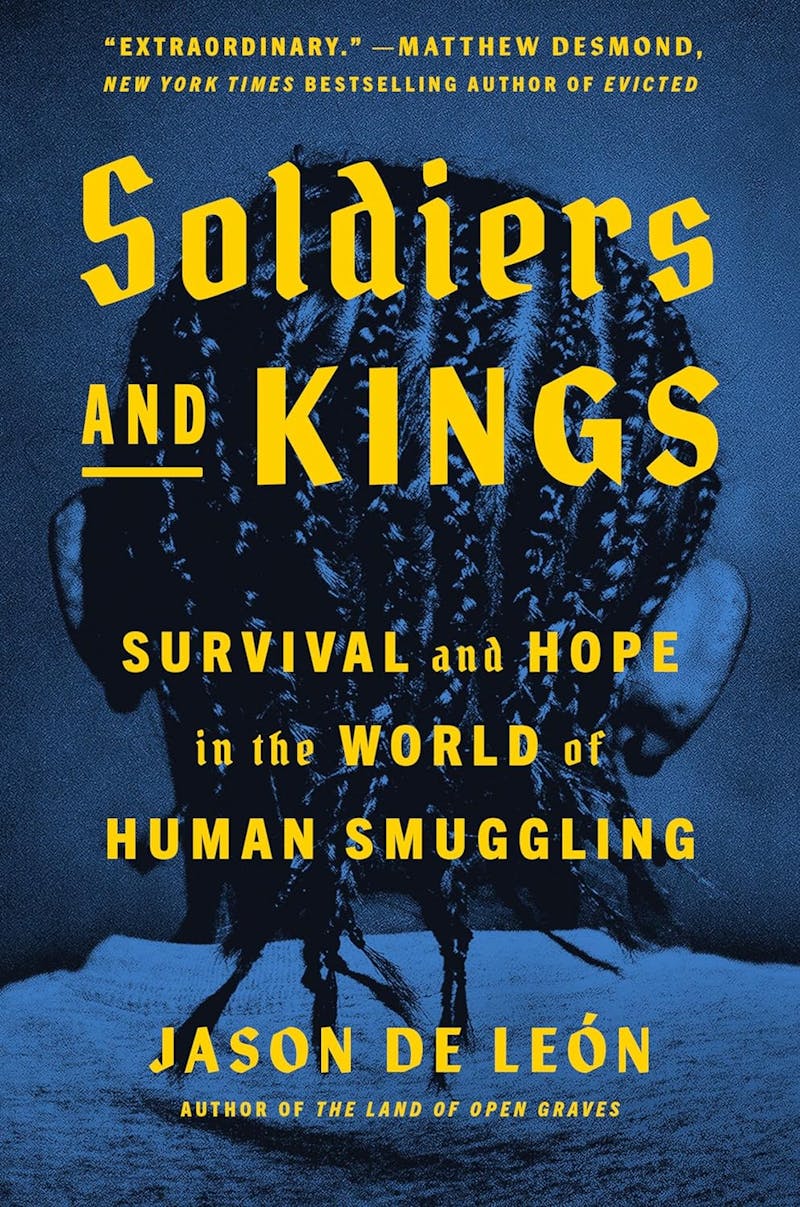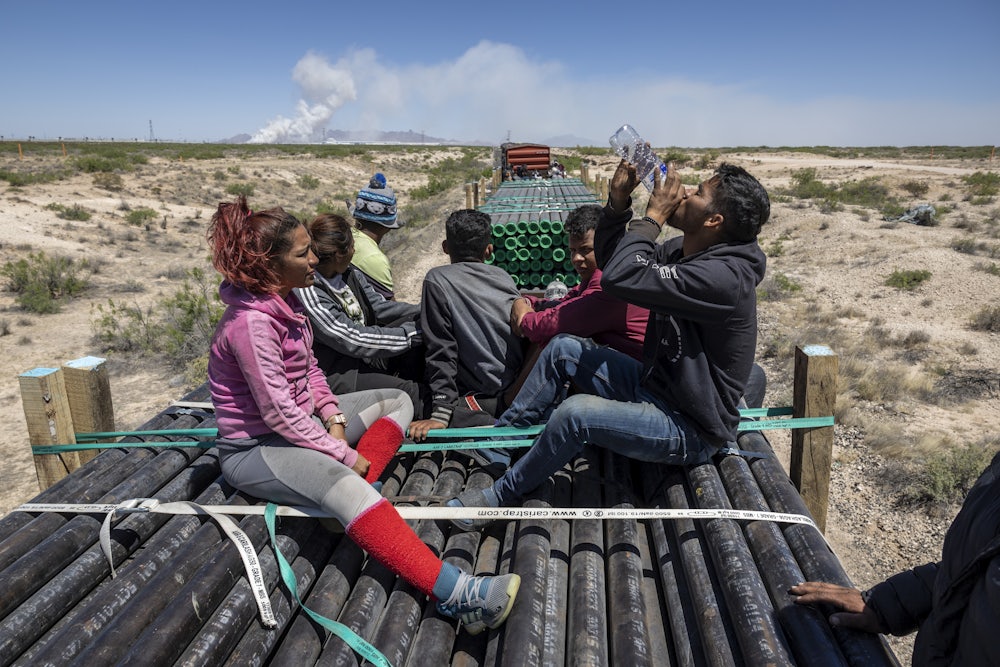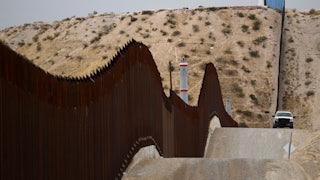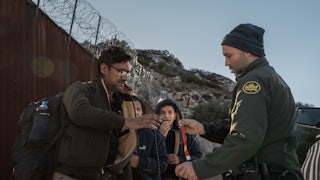Of all the individuals and institutions implicated in the global migration crisis, you’d be hard-pressed to find a figure more universally detested than the human smuggler. U.S. immigration authorities routinely vilify the “ruthless smugglers and transnational criminal organizations who exploit vulnerable migrants” with “disinformation.” Smugglers, one Customs and Border Protection officer recently claimed, treat migrants as a “commodity” no different from “vegetables or drugs.” In these polarized times, villainizing those who make money helping others illegally cross international boundaries has provided a rare point of bipartisan consensus. “Smugglers use migrant children as human pawns to exploit our laws and gain access to our country,” thundered Donald Trump in his 2019 State of the Union Address. They’re “out recruiting,” President Joe Biden said last year, trying to “convince migrant groups to cross illegally.”
“Everyone says that we are all bad, but that’s not true,” a Honduran smuggler working in southern Mexico tells anthropologist Jason De León in his new book, Soldiers and Kings. “It’s just that no one ever listens to our stories.” This is at once a somewhat trite sentiment and a basic truth about this hypervisible, poorly understood occupation, whose practitioners are often typecast, in De León’s formulation, as “pot-bellied Latinos with silver-capped teeth and slick hair” who “reek of cologne and drive shiny trucks bought with the hard-earned (or borrowed) money of desperate people trying to get to la USA.” De León set out to correct these misperceptions, to understand who smugglers are and how and why they get caught up in the work that they do. For nearly seven years, the former MacArthur fellow listened to their stories during impromptu tattoo sessions, in between bouts of partying in ramshackle safe houses, and over meals of roasted iguana on the tracks of la bestia, the Mexican trains so-named for their tendency to devour the limbs and lives of migrants hitching rides north.

“You will not find any crime kingpins on the train tracks in Mexico,” De León reports. “What you will find are desperate people living complicated, ambiguous, and often violent lives.” The labor smugglers perform is “necessary and sometimes lifesaving” for those whose flight from poverty, violence, and climate catastrophe crashes into a gauntlet of ever-tightening border controls, he writes. But they can “also be thieves, traffickers, murderers, and/or rapists.” Many are just as poor as the migrants who purchase their services—one of the main smugglers profiled in the book rarely has more than $20 to his name—and have often themselves fled from the same increasingly unlivable locales, turning to smuggling after either failing to make it to the United States or being deported. Most have witnessed or been victims of horrifically barbarous acts, often at a young age, and seem to exhibit the typical symptoms of PTSD.
De León makes clear that he is not seeking to airbrush the more unsavory realities of smuggling work. Instead, his book forces us to consider multiple truths: that human smuggling is indeed an “exploitative and violent” process for the human beings forced to rely on it, and that those who “try to make a living guiding people across hardening geopolitical boundaries are themselves human”: flawed, complex, capable of both cruelty and mercy. What is inhuman, De León suggests, is the structural forces that set this entire system of clandestine movement in motion. Human smuggling is a symptom of the grotesque inequalities generated by capitalism and the draconian border policies erected to enshrine them. By training such a close lens—quite literally, as the book is filled with intimate photographs of smugglers taken by De León’s longtime collaborator, Mike Wells—on the lives of those who often take the brunt of the blame for the migration crisis, De León throws our attention back to these deeper structures. Wherever a border wall bisects two unequal societies, he writes, you’ll find “desperate migrants and enterprising smugglers on the other side, working their way over, under, and through those barricades at all costs.” So do we blame the smugglers, or do we blame the walls and the societies that built them?
For more than a decade, De León has traversed the Western hemisphere, tracing the hidden traumas of the migrant crisis from Queens, New York, to Cuenca, Ecuador. His first book, The Land of Open Graves, based on five years of fieldwork in and around the Sonoran Desert, was a stunning ethnographic examination of the murderous consequences of “prevention through deterrence,” the Clinton-era border policy that beefed up enforcement at popular urban ports of entry, funneling migrants into remote desert regions where thousands perished over subsequent decades. De León finished his research for that book at a major inflection point in the dynamic of undocumented migration into the U.S., a period that provided the impetus for his new project. During the summer of 2014, thousands of unaccompanied children from Central America arrived at the U.S.-Mexico border, fleeing growing violence and poverty in Honduras, El Salvador, and Guatemala. The flood of children generated a sustained political crisis for the Obama administration, which responded by pressuring Mexico to crack down on migration from the Northern Triangle countries. The result was Programa Frontera Sur—literally, the “Southern Border Program”—a Mexican policy that ratcheted up immigration detention and enforcement, particularly on la bestia.
From the U.S. perspective, De León explains, Programa Frontera Sur was effectively an “extension of prevention through deterrence,” in that it further outsourced and invisibilized the dirty work of clamping down on desperate migrants attempting to make it to the U.S. If the 1990s-era policy farmed out this often-deadly task to the desert’s scorching temperatures, predatory fauna, and inhospitable terrain—where nature picks corpses clean, turns bones to dust, and effectively “sanitizes the killing floor,” in De León’s memorable phrasing—Programa Frontera Sur did something similar with Mexico’s vast geography and its (often corrupt and violent) immigration enforcement apparatus. And just as prevention through deterrence ended up fueling smuggling across the U.S.-Mexico border, so too did Programa Frontera Sur. (“It’s simple. Immigration gets tougher and we invent new routes,” one smuggler puts it to De León matter-of-factly.) By fragmenting traditional migration paths through Mexico, the policy increased reliance on smuggling, helping transform it from a “mom-and-pop business into a billion-dollar global industry” and putting the subjects of De León’s book to work.
De León first encounters them one year into this sea change in immigration enforcement in Pakal-Na, a working-class Mexican town near the Guatemalan border that has become a major waystop for Central American migration. The five Honduran nationals—three men, two women—to whom De León devotes the bulk of his attention are denizens of what they ironically refer to as the “Pleasure Palace,” a cardboard “communal rug” in front of a migrant shelter where people “eat, sleep, kill time, kill each other, drink, do drugs, sell drugs, talk shit, and involve themselves in various activities associated with clandestine movement.”
De León’s long-term immersion in the lives of the Pleasure Palace crew gives him a privileged insight into the conditions that chased them out of their native country, which boasts both the second-highest poverty rate and the second-highest homicide rate in all of Latin America. The book lingers on each of their stories, but the ingredients are startling in their general consistency: abandonment by older relatives forced to migrate north; death (by murder or disease) of fathers, husbands, brothers, best friends; backbreaking labor on a tiny plot of land or in a street-corner stall; paltry wages barely enough to maintain “plywood houses with mud floors”; extortion or recruitment by local gangs. Nearly all of them have witnessed the killing of a loved one. It can be easy to forget, given their typecasting as transnational criminal masterminds, that most of the smugglers De León encounters have fled their homes long before their 18th birthdays.
With the Pleasure Palace as its geographic and narrative core, the book floats from smuggler to smuggler and from present to past. In a way, this structure befits the lives under inspection, which unfold in a “violent world of cycles with no end in sight.” This is a world where the same gangs that have chased you out of your childhood home show up again on the migrant trail; where you are perennially at risk of being picked up by immigration agents and deported back home, only to be forced to head north once again; where a smuggler you befriend is liable to disappear for months, stories of their death circulating “like a game of migrant telephone,” before they suddenly resurface.
Because these low-level smugglers know little about the broader criminal networks that facilitate their (meager) living, the book generally substitutes breadth of view with depth of detail. De León vividly renders the polyglot slang of the Pleasure Palace crew, picked up during undocumented stints in the U.S. working in low-wage industries. He captures their gallows humor and improvised religiosity (one smuggler reads a passage from the Book of Revelation before every trip). He lingers on poignant moments in which they express a desire to leave the smuggling world and find “a normal life like the people you see going to work and coming home to their houses and relaxing without any worries,” as another smuggler puts it. But he also doesn’t shy away from depicting the thrilling (if fleeting) pleasures that come with their line of work—the ways that moving people on the migrant trail can open up “worlds of adventure” for kids perpetually on the run.
As his fieldwork branches out from Pakal-Na across Latin America and the U.S., De León is ultimately able to work his way up the chain of smuggling command, introducing us to the book’s so-called “kings” (though they might better be described as the smuggling industry’s middle managers). We meet Flaco, who, like his “soldier” underlings, fled Honduras at the age of 13. He later puts in a decade-plus of work in Los Angeles for a Honduran gang, which both lands him in prison for a violent crime and gives him connections that later help him broker safe passage for migrants moving north, especially as transnational gangs came to exert increased control over the migrant trail in the wake of Programa Frontera Sur. On a slightly higher rung is a smuggler De León calls Kingston, a true veteran of the business whose roundabout journey to smuggling is the book’s most memorable: recruitment first by local gangsters and then by the U.S.-backed Honduran military as a child soldier; aimless wandering across international borders during the pre-9/11 era; gang activity in the Bronx for the Bloods; 25-to-life for violently avenging the mutilation of a best friend; stints in New York’s most infamous prisons (Rikers, Attica, Sing Sing); a successful sentence commutation; deportation back to Honduras; and into a long career facilitating illicit movement.
If the low-level smugglers at the Pleasure Palace exist in ambivalent relation to the industry, Flaco and Kingston are more firmly ensconced. They have grown comfortable with violence, are more openly acquisitive, and therefore are more distasteful characters, even if De León openly admits that he is “charmed” by their charisma. They both speak incessantly of cash: “Motherfucker, I’m making it! $1,500, $5,000, $10,000. Goddamn!” Kingston boasts. When De León asks what the most important thing to know about the smuggling business is, Flaco replies, “Money, money, money.” But their lives also possess a tragic dimension. De León cites research on how former child soldiers like Kingston “have difficulties in controlling aggressive impulses and have little skills for handling life without violence.” Moreover, both Kingston and Flaco are caught between the Scylla of their obligations to high-level gang members and the Charybdis of their criminal records in the U.S., making it difficult for them to contemplate leaving the world of smuggling, even as it grows increasingly violent and unstable in the wake of Programa Frontera Sur. “It’s like a tattoo,” Kingston laments of his life in “el show,” his name for the smuggling industry. “All that you do in your life is recorded on you like a tattoo.”
How does one adequately represent the perpetual motion machine that is the illicit migration of millions of people through the Western hemisphere? How to sketch the range of actors and forces—governments, nongovernmental organizations, transnational gangs, drug cartels, climactic patterns, capital flows—that shape clandestine movement? De León is admirably up-front about the representational limitations of any single project, even one based on such extended and immersive work. In a world where “you never know the truth about what is happening,” as one smuggler puts it, the best any observer can hope for is to capture a “blurry snapshot of a fragment” of the whole picture. “The diagrams we draw will always be missing pieces,” he writes.
And so certain perspectives will inevitably be sidelined. In his previous book, for example, De León mostly focused on the experiences of men crossing the U.S.-Mexico border, which largely kept him from learning about the ubiquitous sexual assault of women on the migrant trail, except “through the eyes of men who bore witness.” There are similar perspectival elisions in Soldiers and Kings. For one, De León informs us up front that, for safety reasons, he decided to never physically travel with smugglers as they moved migrants north, which means that the book doesn’t illuminate much about how migrants encounter their guias while making the 1,600-mile journey through Mexico. When De León writes of how Flaco experiences “the thrill of calling the shots and being a boss” on the migrant trail, where he is “an authority figure, an expert, a king,” one is left to imagine how this might be experienced from the other side. De León also tells us that he avoided smugglers who gave off a “bad vibe,” especially ones he suspected of being implicated in abuse and assault. As a result, the violent targeting of migrants that is so ubiquitous in el camino is largely rendered off-stage, entering the narrative solely in the comments of the characters De León has come to trust.
Yet the book’s great virtue is in its close attention to the individual lives of its small group of central characters. De León picks his epigraph from American country singer Jason Isbell: “Are you living the life you chose? / Are you living the life that chose you?” The lyric gestures at De León’s interest in toggling between the macro and the micro: the globe-spanning, incomprehensibly vast forces that have brought these smugglers’ lives into being, as well as their own individual struggles to make something of what the world has made of them.
De León ends the book with an obligatory “what to do” chapter, but the solutions he proposes are delivered with something of a shrug. “I am an anthropologist, not a policymaker,” he writes, lamenting that “the types of observations and recommendations that my kind tends to make only frustrate those who are looking for easy answers to incorporate into campaign slogans and white papers.” Building a world that would put the Pleasure Palace crew out of business would require, he argues, addressing “the monstrous injustices created by capitalism”: “poverty, political corruption, the drug trade, transnational gang violence, climate change patterns created by the richest countries and disproportionately felt by the poorest.” But for the foreseeable future, our policy landscape will be dominated by people possessed of the “myopic and naïve vision,” largely shared by our current Democratic president, that illicit migration is just a national security problem to be solved with more guns and barbed wire.
Until we can come to address the root causes of migration and its “ugly symbiote,” human smuggling, we’ll have to reckon with the fact that, as De León writes, “cemeteries across Central America are full of the skeletons of people just like” the ones profiled in this book: “children born into generational poverty whose bleak futures are predetermined before they can even speak; kids who live fast and die fast because those are often the only choices they are given.” There will be many more like them.






